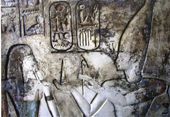
© Modified from Turner/AGUWinds circle clockwise around Antarctica, whip off Victoria Land and create a vortex of cold storms (dark blue) off the Ross Sea, where sea ice is expanding. The vortex also draws in warm (red) air from South America, which warms the Antarctic Peninsula.
It's the southern ozone hole whatdunit. That's why Antarctic sea ice is growing while at the other pole, Arctic ice is shrinking at record rates. It seems CFCs and other ozone-depleting chemicals have given the South Pole respite from global warming.
But only temporarily. According to John Turner of the British Antarctic Survey, the effect will last roughly another decade before Antarctic sea ice starts to decline as well.
Arctic sea ice is decreasing dramatically and reached a record low in 2007. But satellite images studied by Turner and his colleagues show that Antarctic sea ice is increasing in every month of the year expect January. "By the end of the century we expect one third of Antarctic sea ice to disappear," says Turner. "So we're trying to understand why it's increasing now, at a time of global warming."
In a new study, Turner and colleagues show how the ozone hole has changed weather patterns around Antarctica. These changes have drawn in warm air over the Antarctic Peninsula in West Antarctica and cooled the air above East Antarctica.


